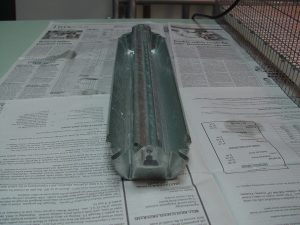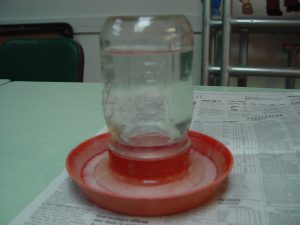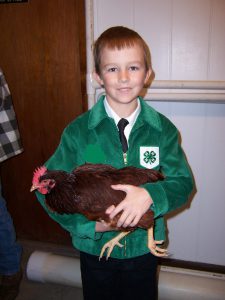When someone enters a feed store this time of year, they are often greeted by the chirping of baby chicks. For many it is hard to resist purchasing some new future laying hens to add to the farmstead. Understanding the requirements these small creatures need to survive will help you raise your new feathered friends successfully.
Brooding Chicks
Chicks need a safe place grow during their early stage of life, until they grow their feathers. They will need a place that will protect them from wind, cold, and rain. Newly hatched chicks need to be kept at about 95º F for the first week of their lives. Then after this first week, they can tolerate temperatures about 5º F cooler each week until they are four weeks old. Most people will brood chicks in a plastic or wooden box, or a wire cage with small mesh and draft protection, and utilize a heat lamp (with a red or white heat bulb) to keep chicks warm. If using a box, shavings are also necessary. Try to avoid using cedar shavings, however. (Draft protection means protecting chicks from wind.)
You can observe chicks to see if they are at a comfortable temperature. If they are all huddled under the heat lamp, they are cold. Move the heat lamp a little closer to the birds. If they are around the edge of the brooder, trying to get as far away from the heat as possible, they are too warm. If they are all mixing around and moving around the entire brooder, they are likely comfortable. Observe them at different times of day to check morning, day, and evening/night comfort.
Feed and Water
The chicks will also need ready access to feed and water in their brooder. The size or number of feeders and water founts will depend on how many chicks you have. You can order chicks from hatcheries and have them overnight shipped through the mail since they have enough nutrients absorbed from the egg to last for up to three days. When they arrive they are typically thirsty. Many people like to dip their beak in their water to make sure all get a drink when they arrive. This also helps introduce your water fount to the birds. Some people will add 1/4 to 1/2 cup of sugar to one gallon of water initially to boost the chicks’ energy level if they appear lethargic upon arrival.
To introduce feed, you might scatter some feed on a flat surface to encourage them to peck at it. Most feed stores sell feeders and water founts designed for chicks. You should feed chicks a chick starter/grower with 20% crude protein. A pre-mixed chick feed will provide all the nutrients the growing chicks need to thrive. These feeds are often medicated. This will help keep chicks from getting coccidiosis. Feed chick feed until the birds are about 18 weeks old. At about 18 weeks, you can switch your chickens to a layer pellet or crumble with 16% crude protein.
Your birds should have access to clean, fresh water and their feed at all times.


Space Requirements
Your chicks should have enough space to move about comfortably and readily access their feed and water. Each chick should have about 1/2 square foot of floor space the first two weeks. Grown chickens need at least 1.5 square feet of floor space in a coop, or about 8 square feet of space per bird in an outside pen or chicken yard. Grown chickens also need 6-10 inches of roost space.

Enjoying your Chickens
A healthy flock of chickens will start with healthy chicks. Keeping your new chicks at he right temperature, protecting them from draft/wind, cleaning their litter regularly, and providing proper feed and water will help you have a good start with your birds. Most people keep chickens for fun and enjoy fresh, home-grown eggs. Many people also enjoy exhibiting chickens in poultry shows, and 4-H provides an excellent opportunity for young people aged 5-18 to learn more about caring for their chickens.
 1
1
